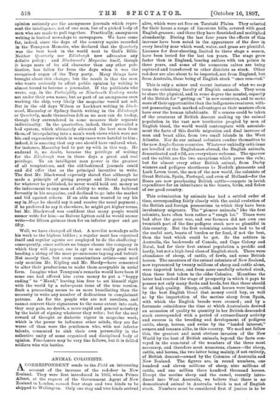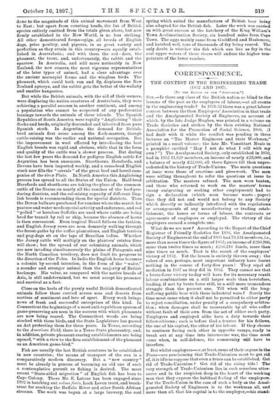ANIMAL COLONISTS.
&CORRESPONDENT sends to the Field an interesting account of the increase of the red-deer in New Zealand. They were first introduced in 1862, when Prince Albert, at the request of the Government Agent of New Zealand in London, caused four stags and two hinds to be shipped to Wellington. Only one stag and two hinds arrived
alive, which were set free on Taratahi Plains. They selected for their haunt a range of limestone hills, covered with good English grasses ; and there they have flourished and multiplied abundantly. During the last four years the effects of this increase have been noted in the appearance of the deer in every locality near which wood, water, and grass are plentiful. Licenses for deer-shooting, limited to three stags a season, have been issued for the last ten years. The stags grow faster than in England, bearing antlers with ten points in three years, and some of the numerous calves are being captured and transferred to other districts as stock. Other red-deer are also about to be imported, not from England, but from Australia, these being of English stock "once removed."
This is only a minor and recent instance of what we may term the colonising faculty of English animals They seem to share the physical, and in some degree the mental, capacity of the British for "getting on" in new countries, and to make more of their opportunities than the indigenous creatures, with- out possessing such marked advantages as their masters often have over the human inhabitants. If a census could be taken. of the creatures of British descent making up the animal population in the vast new territories peopled by men of English blood, the world would contemplate with astonish- ment the facts of this double migration and dual increase of man and beast alike, from two small islands in the West Atlantic. Nor do our animal colonists confine themselves to the new Anglo-Saxon countries. Whatever unkindly criticisms are levelled at the Englishman abroad, the English animals, domesticated and wild, are everywhere welcome. The sparrow and the rabbit are the two exceptions which prove the rule; but for almost every other British animal, from Derby winners and pedigree shorthorns to Norfolk pheasants and Loch Leven trout, the men of the new world, the colonists of Great Britain, Spain, Portugal, and even of Holland—for the Boers are now purchasing British cattle—compete in lavish expenditure for an inheritance in the beasts, birds, and fishes of our good country.
This colonisation by animals has had a settled order of time, corresponding fairly closely with the social evolution of the British and foreign possessions to which they have be,en, involuntary migrants. The "pioneer animals," like the first colonists, have often been rather a "rough lot." Times were bad after the great war, and our farmers did not own one twentieth part of the fine pedigree stock now so plentiful in. this country. But the first colonising animals had to be of the useful sort, beasts of burden or for food, if not the best, then the best which could be got. So the settlers in, Australia, the backwoods of Canada, and Cape Colony and Natal, had for their first animal population a prolific and hardy, but not a high-bred class of English stock. There were abundance of sheep, of cattle, of fowls, and some British horses. The ancestors of the animal colonists of New Zealand, now represented by twenty millions of sheep and cattle alone, were imported later, and from more carefully selected stock, than those first taken to the older Colonies. Meantime the latter had reached the stage of prosperity in which it pays to possess not only many flocks and herds, but that those should be of high quality. Sheep, cattle, and horses were improved by the best English blood that money could buy, as well as by the importation of the merino sheep from Spain, with which the English breeds were crossed ; and by a fortunate coincidence the time at which Australasia desired an accession of quality to quantity in her British-descended stock corresponded with a period of extraordinary activity and success in the breeding and development of pedigree cattle, sheep, horses, and swine by the "landed interest,' owners and tenants alike, in this country. We need not follow this, the greatest and most obvious invasion of the New World by the host of British animals, beyond the facts con- veyed in the sum-total of the numbers of the three most necessary, and therefore most numerous, classes—the sheep, cattle, and horses, the two latter being mainly, if not entirely, of British descent—owned by the Colonies of Australia and New Zealand. The figures are, in round numbers, one hundred and eleven millions of sheep, nine millions of cattle, and one million three hundred thousand horses. Exceptthe merino sheep and the camel, recently intro- duced into West Australia, we believe that there is no domesticated animal in Australia which is not of English stock. Numbers must be considered first if justice is to be
done to the magnitude of this animal movement from West to East ; but apart from counting heads, the list of British species entirely omitted from the totals given above, but now firmly established in the New World, is no leas striking. All other domesticated forms—pigs, all breeds of English dogs, prize poultry, and pigeons, in as great variety and perfection as they attain in this country—are equally estab- lished in Australasia ; and with them the red - deer, the pheasant, the trout, and, unfortunately, the rabbit and the sparrow. In Australia, and still more noticeably in New 'Zealand, the new comers, the most vigorous representatives of the later types of animal, had a clear advantage over the ancient marsupial forms and the wingless birds. The pheasant, which could both run and fly, displaces the New Zealand apteryx, and the rabbit gets the better of the wallaby and smaller kangaroos.
But while the British animals, with the aid of their owners, were displacing the native creatures of Australasia, they were achieving a parallel success in another continent, and among • a population who cannot be suspected of any preferential leanings towards the animals of these islands. The Spanish Republics of South America were rapidly "Anglicising" their flocks and herds, originally descended and inherited from pare Spanish stock. In Argentina the demand for British. bred animals first arose among the flock-masters, though cattle-raising was the earlier and national occupation. Bat the improvement in wool effected by introducing the best English breeds was rapid and obvious, while that in the form and quality of the cattle was 'a slower process. But during the last few years the demand for pedigree English cattle for Argentina has been enormous. Shorthorns, Herefords, and Devons have been imported weekly, and a cross-bred English stock now fills the " corrals " of the great beef and bovril com- panies of the rivEr Plate. In North America this Anglicising process has spread to all the States of the Union. Half-bred Herefords and shorthorns are taking the place of the common -cattle of the States on nearly all the ranches of the beef-pro- ducing districts, and the colonising capacity of different Eng- lish breeds is recommending them for special districts. Thus the Devon bulls are purchased for ranches where the search for pasture and water needs special activity and endurance, and red -" polled" or hornless Saffolks are used where cattle are being bred for transit by rail or ship, because the absence of horns is then convenient. Even tropical Brazil follows the fashion, and English Jersey cows are seen demurely walking through the forest-paths by the coffee plantations, and English terriers and pug-dogs sit on the laps of Brazilian ladies. Whether the Jersey cattle will multiply on the planters' estates time will show ; but the spread of our colonising animals, which are now invading simultaneously the plains of Patagonia and the North Canadian territory, does not limit its progress to the direction of the Poles. In India the English horse becomes a colonist by second intention, in the form of the " waler," a sounder and stronger animal than the majority of British hackneys. His value, as compared with the native breeds of Asia, is still undetermined, but we must accept his presence -and survival as a fact.
Close on the heels of the purely useful British domesticated animals follow those carried across seas and deserts from motives of sentiment and love of sport. Every week brings news of fresh and successful enterprises of this kind. In 'Connecticut the beginnings of a most anti-republican system of game-preserving are seen in the success with which pheasants are now being reared. The Connecticut woods are being stocked with these birds, and the State Legislature has passed an Act protecting them for three years. In Texas, according to the American Field, there is a Texas State pheasantry, and, in addition, private pheasant-rearing establishments are being opened, "with a view to the firm establishment of the pheasant as an American game-bird."
Fish are usually the last British creatures to be established in new countries ; the means of transport of the ova is a comparatively modern discovery. But a "new country" must be already in process of becoming an old one if such a contemplative pursuit as fishing is desired. The most recent " State-aided migration" of English fish has been to Cape Colony. There Mr. E. Latour has been engaged since 1892 in hatching out salmo fario, Loch Leven trout, and brook- trout for stocking the Buffalo River and other South African streams. The work was begun at a large brewery, the cool
spring which suited the manufacture of British beer being also adapted for the British fish. Later the work was carried on with great success at the hatchery of the King William's Town Acclimatisation Society, six hundred miles from Cape Town. The eggs mainly came from Guildford and Haslemere, and hatched well, tens of thousands of fry being reared. The only doubt is whether the fish which can live as fry in the cool upper waters of these rivers will endure the higher tem- perature of the lower reaches.







































 Previous page
Previous page